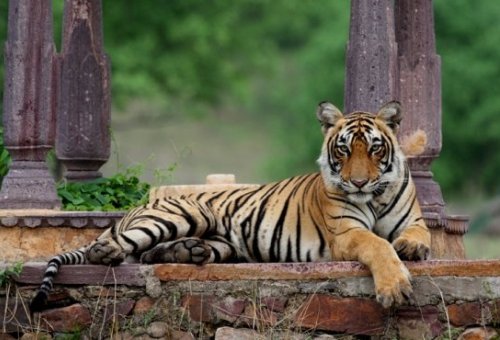Stars for the Star: Tiger Conservation Through Celebrities

The most recent celebrity who has lent his name for the cause of saving the tiger is Hollywood actor Leonardo DiCaprio. Having met Jairam Ramesh in New York this September at the reception of the Coalition of Rainforest Nations, DiCaprio reportedly expressed his interest to play a crucial role in sensitizing the global community to the cause of the Indian tiger. In his statement released through the World Wide Fund for Nature (WWF) earlier this year, the actor had said “Key Conservation efforts can save the Indian tigers species from extinction, protect some of the planet’s last wild habitats and help sustain local communities surrounding them”.
DiCaprio is not the first celebrity to get behind the cause of saving the Indian tiger. And going by the trend, he definitely isn’t the last. Several cricketers and Bollywood stars have extended their support for the big cat. Sachin Tendulkar, ace batsman of the Indian cricket team who needs no introduction world over is known to have dedicated one of his splendid centuries to the tiger. Rahul Dravid was the ‘star’ participant at the Fifth Bengal Tiger Consultation organised by Sanctuary Asia last year with support from Delhi Greens. He sat through the entire proceedings listening intently, participating vividly and avoiding all cricket questions when it came to the media, and telling them to focus on the cause instead! M.S. Dhoni is now the Honorary Wildlife Warden of Corbett National Park.
Several others such as John Abraham, Priyanka Chopra, Amitabh Bachchan Kajol, Aamir Khan, Hrithik Roshan, Preity Zinta have all come forward, some as green ambassadors others attempting a goodwill gesture for saving the tiger, elephants and our biodiversity and forests. This alliance with celebrities is relatively a new phenomenon in conservation in India. Global organisations like PETA (People for the Ethical Treatment of Animals) has used it since long, even to the extent of getting celebs agree for naked photo shoots. “I’d rather go naked than wear fur” or “Sometimes too much sex can be a bad thing” are slogans celebs have stood by in bare minimum, and raised awareness against wearing fur, getting pets neutered or promoting vegetarianism.
Two years back, the World Bank had teamed up with the Smithsonian’s National Zoological Park in Washington D.C. and with celebrities like Harrison Ford, Bo Derek and Robert Duvell in addition to the Global Environmental Facility to help save tigers from extinction. An event to commence World Bank’s Tiger Conservation initiative was organised on June 9, 2008. This was unique for an institution whose public mandate is to fight poverty in developing countries rather than conserve endangered species.
India made no delay in refusing World Bank’s offer for a loan for such an initiative. Conservationists in India have raised doubts on the bank’s present and past initiatives. It is felt that World Bank’s projects–even those of forestry, plantations and eco-development–have destroyed tiger habitats. The Government of India, however, refused the bank’s offer for a loan to save the tiger stating that it “feels that it has enough resources to tackle tiger conservation on its own and the Bretton Woods organization would not be able to provide any technical input that India cannot assemble domestically.”
Returning to the issue of celebrity involvement in conservation, environment writer Dan Brockington argues in his book Celebrity and Environment that the flourishing of celebrity and charismatic conservation are producing more commodified and commercial conservation strategies, making conservation an even more important means of generating profit. His key argument is that in conservation the incursions of celebrity are part of a deeper embedding of conservation within capitalism. The strategies of selling nature may well work, in the sense that they serve conservation goals, they also extend the reach and power of market relations.
There is a powerful economic logic behind the growth of celebrity conservationists. Being a celebrity of any sort, conservation or otherwise, is a business. It requires self-promotion: appearing in public often and preferably being paid to do so. It requires selling commodities, either other people’s (such as newspapers, films, TV channels and books) or one’s own. What we can all hope and pray for is that in amidst all these measures, the majestic tiger–an umbrella species for the protection of our forests–remains the real celebrity. And that it is the number of tigers in the wild that increases much more rapidly than the number of celebs now ‘working hard’ to save the tiger!
Image courtesy Dr. Dharmendra Khandal, Tiger Watch




I’m truly enjoying the design and layout of your website. It’s a very easy on the eyes which makes it much more pleasant for me to come here and visit more often. Did you hire out a developer to create your theme? Excellent work!